In 2009, the UK’s Royal Society published one of the seminal studies on the emerging field of climate geoengineering, Geoengineering the Climate. This week, it released a successor report, focused on one of the recognized sub-categories of geoengineering, “greenhouse gas removal,”(GGR) also often referred to as “carbon dioxide removal” or negative emissions technologies (NETs).
The UK’s Royal Society has just released a report on “greenhouse gas removal” (GGR)—a diverse set of technologies and practices for removing greenhouse gases, like carbon dioxide, from the atmosphere and sequestering them. GGR is also sometimes called “carbon dioxide removal” or “negative emissions.” This report, written in conjunction with the Royal Academy of Engineering, comes nearly a decade after the Royal Society’s seminal 2009 report on climate engineering, Geoengineering the Climate, which considered both GGR and solar geoengineering methods.
In this post, I will attempt to summarize the key conclusions of the report, and then briefly discuss a number of outstanding issues that should be addressed in future analyses of GGR options.
- Overview
- The large-scale deployment of GGR options will likely prove to be critical in meeting the Paris Agreement’s objective of reaching net-zero emissions as well as its temperature objectives: holding temperatures to 2°C above pre-industrial levels will likely require removing several hundred gigatons of carbon dioxide, and holding temperatures to 5°C would take “close to a thousand” gigatons
- While the initial focus in terms of potential deployment of GGR approaches was on forests and bioenergy coupled to carbon capture and storage (BECCS), potential ecosystem impacts and land constraints counsel in favor of scrutinizing a “suite” of options to capture carbon dioxide, falling into three broad categories:
- Increasing biological uptake;
- Increasing inorganic reactions with rocks;
- Direct air capture from the atmospheric with engineering approaches
- The report makes eight specific policy recommendations related to GGR (see section 5 of this post)
- Some of the specific options examined in the report include the following:
-
Afforestation, reforestation, and forest management:
- Potential carbon dioxide sequestration potential of these options ranges from 3-18GtCO2/yr., dependent on factors including “assumed land availability, location, forest type and management as well as economic and biophysical constraints;”
- Large-scale forestation could pose serious environmental risks, including potential negative impacts on biodiversity if natural forests or other natural ecosystems are replaced with fast-growing or higher biomass tree plantations, as well as life-cycle impacts associated with use of energy, fertilizer, pesticides and volatile organic chemical emissions. Conversely, conversion of croplands or degraded land with forests could enhance biodiversity and produce other ecosystem benefits;
- There is a compelling need for sound characterization of optimal locations for planting forests, as such efforts might actually increase warming in snow-covered boreal localities and regions. Moreover, potential displacement of agricultural production that might exacerbate food security must be addressed, either by a focus on agroforestry or prioritization of degraded land or previously forested land;
- Many parties to the Paris Agreement have already incorporated forest initiatives in their Nationally Determined Contributions, representing a full quarter of mitigation pledges to date.
-
Wetland, peatland and coastal habitat restoration:
- Peatlands and coastal wetlands store an astounding 44-71% of the globe’s terrestrial biological carbon, with large areas of these ecosystems subject to degradation that threatens carbon sequestration;
- There is substantial experience with restoring habitats of this nature, with potential additional sequestration ranging from 0.4-18tCO2 per hectare annually, including many relatively low-cost options;
- Restoration programs can yield important co-benefits, such protection from storm surges. However, there are also risks associated with implementation, such as decreasing surface albedo, and thus potentially increasing warming in some regions, and release of non-carbon dioxide greenhouse gases, such as methane and nitrous oxide.
-
Soil carbon sequestration:
- Soil carbon sequestration options include crop management, nutrient management, reduction of tillage, improved grassland varieties and fire management;
- Technical potential for soil carbon sequestration ranges from 1.1-11.4 GtCO2/yr., with more conservative estimates of 6.9 GtCO2/yr.;
- Soil carbon sequestration could yield substantial co-benefits, including enhancing crop productivity. However, it also could pose risks and challenges, including increasing other greenhouse gas emissions and posing difficult monitoring and verification issues;
- While there are efforts in place currently to enhance soil carbon sequestration, such as the “4 Per 1000 Initiative,” there are major challenges to scaling up such initiatives, including a lack of financial incentives, and limited knowledge of the benefits of such programs among farmers and land managers.
-
Biochar:
- Biochar is charcoal produced by thermal decomposition of biomass at elevated temperatures in inert environments that can be applied as a soil amendment. It can facilitate storage of carbon and stabilize organic matter in soils. Studies estimate that biochar can remove 2.1-4.8 tCO2 per ton added to soils;
- Application of biochar could yield co-benefits, including enhancement of soil fertility and stabilization of heavy metals. However, concerns have also been raised about the need for dedication of large swaths of land for production of requisite biomass, decreases in surface albedo, and potential releases of methane and nitrous oxide, though some benefits indicate the opposite in terms of this latter consideration;
- Policy and social concerns include potential negative perceptions about the facilities used to produce biochar (“incineration in disguise”), and regulatory constraints on the amount of biochar that can be applied to soils.
-
Bioenergy with Carbon Capture and Storage:
- Bioenergy with carbon capture and storage entails wedding biomass combustion to produce energy with carbon capture and storage technologies. Global sequestration potential could be as high as 10GtCO2/yr. However, the report cautions that injudicious management strategies and land-use choices could even result in BECCS producing a net increase in greenhouse gas emissions;
- BECCS could require substantial amounts of land, 0.03 to 0.06 ha per tCO2, and 60 m3 per tCO2 of water. Production of dedicated bioenergy crops could substantially impact food prices and significantly impact the globe’s nitrogen cycle;
- Substantial regulatory requirements for BECCS include crediting national emissions inventories should bioenergy feedstocks be exported and the integrity of carbon dioxide storage.
-
Ocean iron fertilization:
- Ocean iron fertilization (OIF) entails placement of nutrients (such as iron or nitrate/phosphate) in oceans to stimulate production of phytoplankton that can take up carbon dioxide. Some of this carbon dioxide can be stored in the deep ocean when phytoplankton die and sink to the bottom in a process known as “the biological pump. The estimated potential of OIF is 3.7 GtCO2/yr., with a total ocean sequestration capacity until the end of this century of 70 to 300 GtCO2.
- OIF risk factors could include potential ecosystem impacts of unpredictable new assemblages of plankton, toxic algal blooms, and production of methane and nitrous oxide.
-
Enhanced terrestrial weathering
- Enhanced terrestrial weathering would seek to accelerate the natural weathering process on silicate rocks, which removes carbon dioxide from the atmosphere and releases metal ions and carbonate and bi-carbonate ions. The most discussed method to effectuate this would be milling silicate rocks containing calcium or magnesium and spreading them over large areas of managed cropland. Recent research indicates that this could remove between 0.5 and 4.0 GtCO2/yr. by 2100 if two-thirds of the most productive cropland soils were treated with basalt;
- Basalt addition to croplands can increase food production and improve soil health. However, there are also a number of risks to human health and the environment with this process, including negative environment impacts associated with mining and processing of rocks, as well as the potential for silicosis if inhaled, decreases in water clarity.
-
Direct air capture and carbon storage (DACCS)
- DACCS can effectuate removal of carbon dioxide from the atmosphere utilizing a “separating agent” to capture the CO2. The carbon dioxide is subsequently “regenerated” with heat or water, which results in the release of the CO2 as a high purity for stream for geological storage, injection into basaltic rock, or utilization. These technologies currently lie between pilot plant development and prototype demonstration in the field;”
- DACCS will require substantial amounts of land, and there would be pollution impacts if fossil fuels are used in the regeneration process;
- Major challenges to large-scale deployment of DACCS include potentially very large energy requirements, which might preclude viability unless met by renewable sources, and high costs (perhaps as high as $600/ton, though at least one company is seeking to bring this down to $100/ton).
-
Other options
- The report also discusses several other options, including ocean alkalinity, marine BECCS, enhancement of ocean upwelling to promote phytoplankton production, and approaches that could sequester greenhouse gases other than carbon dioxide, including methane and nitrous oxide.
- Cross-Cutting Issues:
Reflecting the report’s advocacy of a portfolio approach to GGR deployment, it includes a section outlining seven “cross-cutting issues” which its authors argue are critical to implementing large-scale GGR. This includes the following:
-
Resources: Critical considerations in this context include potential competition between certain GGR options for the same resources, such as BECCS and forestation, imposing land requirements (for example, the upper-end of forestation scenarios could require twice as much land as is currently under cultivation, with potentially huge impacts on food prices this century), substantial water demands, and in the case of some options, such as Direct Air Capture, very high energy demands;
-
Storage: Some storage options, such as those associated with BECCS, may pose serious issues in terms of permanence. Other options provide the prospects of much longer-term storage, including mineral carbonation and reaction of carbon dioxide with limestone;
-
Environment: Environmental considerations include potential biodiversity impacts, production of greenhouse gases other than carbon dioxide with much higher global warming potential, and production of pollutants through application or due to raw materials, transport or infrastructure;
-
Science and technology: Many potential GGR options will require significant research and development given uncertainties about feasibility and scale; however, this may prove to be the most serious constraint for many GGR approaches. Other serious concerns include potential scalability of many of these options given concerns of sustainability and cost, and the security and permanence of storage of greenhouse gases;
-
Economics: Current carbon prices in most jurisdictions are too low to drive large-scale deployment of many GGR technologies. However, there is some impetus to increase carbon prices over time, with prices of $50-100 per tCO2 potentially sufficient to making many of GGR options economically viable. Regulatory mandates could also help to address market failures;
-
Legislation: The report outlines an array of legislative/regulatory requirements at the national level, including developing reporting requirements, especially for land-based options, sustainability mandates that may constraint scalar deployment of some options, and effective incorporation of GGR options in nationally determined contributions;
-
Social aspects: Societal perceptions of GGR options could limit deployment of GGR, but could also lead to a “moral hazard” that could reduce commitments to mitigation. The report suggests some of the issues that may of primary concern to the general public, including impacts of local landscapes and environments, and more broadly by societal imaginaries of “how the world should look in the future” based on overarching values
- Scenarios:
- The report outlines scenarios at both the United Kingdom and international level to assess how individual GGR options and cross-cutting issues might influence the potential role of GGR in future climate response portfolios;
- In terms of the United Kingdom, the report concludes that GGR could provide 130 MtCO2 of sequestration by 2050, assuming, inter alia, maximum deployment of BECCS and DACCS. However, this scenario would prove “challenging and costly,” including the need for application of carbon pricing mechanisms to carbon dioxide removal, establishment of subsidies to drive land practices for carbon sequestration, and research and development of a number of technologies, including advanced terrestrial weathering, biochar and direct air capture;
- The report outlines a global scenario in which 810 GtCO2 could be sequestered by 2100. This includes large-scale deployment of forest and soil sequestration options, BECCS, DACCS, Biochar (with substantial deployment more likely at scale at the dawn of the next century), and enhanced terrestrial weathering. Some options, such as ocean alkalinity are characterized as “uncertain,” while ocean iron fertilization is deemed to be “unlikely to prove useful at scale” (because of inefficiencies of net removal to the deep ocean). Many challenges, however, are also discussed, including questions of saturation and permanence of many land-based options, which will necessitate continual management and monitoring, environmental concerns, and potential impacts on food prices in the case of forestation and BECCS.
- Report Recommendations:
The final section of the report outlines a number of recommendations that build on lessons learned from the development of the scenarios developed above. These include the following:
- Continuing to press for escalated commitments to reduction of emissions of greenhouse gas emissions given the costs and social and logistical challenges attendant to large-scale deployment of GGR;
- Implementation of a suite of GGR responses, including both existing land-based approaches, such as forestation and soil carbon enhancement, but also industrial options such as Direct Air Capture;
- Build CCS infrastructure. This necessitate a “rapid ramp-up” of an industry that is in relative infancy, as well as substantial research and development on options that could augment sedimentary storage, such as carbonation and limestone reaction with carbon dioxide;
- Incentivize demonstrators and early-movers to drive cost-discovery and reduction of costs. Governments should also use carbon pricing and other mechanisms to drive GGR research and deployment;
- Establish a framework to assess sustainability of GGR deployment, including rigorous life cycle assessments and environmental monitoring;
- Incorporate GGR into regulatory frameworks (such as the range of options that can receive government subsidies in sectors such as agriculture) and carbon trading systems;
- Establish an international science-based standard for monitoring, reporting and verification of GGR options.
Conclusions:
As was true in its 2009 report, the Royal Society has produced an excellent analysis of the exigencies motivating consideration of non-traditional responses to climate change, the potential risks and benefits of GGR approaches, and some of the things that society would need to do to develop these options in the future. However, there are a number of issues that could have justified more attention in the report:
- While there are numerous references in the report to the challenges associated with large-scale sequestration of carbon dioxide, there are only a few, and extremely cryptic, references to potential avenues for utilization, including for energy production, chemicals, fertilizers and materials. Most notably, the report failed to discuss for the roles that enhanced oil recovery (EOR) by injection of carbon dioxide might play in upscaling GGR: EOR could substantially improve the economic viability of CCS in the near term, but at the same time, it could roil the political waters by generating opposition among those who believe that EOR could derail efforts to rapidly decarbonize the world economy;
- The report gives extremely short shrift to so-called “Blue Carbon” options to increase carbon sequestration in coastal and ocean ecosystems, including mangrove forests, seagrass meadows or intertidal saltmarshes, as well as the potential for algae. Given the potential co-benefits of these approaches, they may have warranted more coverage;
- While the report includes numerous references to the Paris Agreement in the context of the NDCs, it did not discuss how its provisions for sustainability and protection of human rights might have implications for the scope and magnitude of GGR deployment. These may prove to be critical issues in terms of notions of equity and justice and potential political support, or resistance, to GGR in the future;
- While the report focuses on legal efforts at the national level to effectuate assessment and regulation of GGR options, it largely ignores the important role that many international treaty regimes might play, including the United Nations Convention on the Law of the Sea in the context of marine-based options; treaties for transboundary impact assessment, such as the Espoo Convention, pertinent international treaties in the context of land-use and forests, the potential role of human rights conventions in cases where GGR options could threaten the rights to food, water and subsistence.
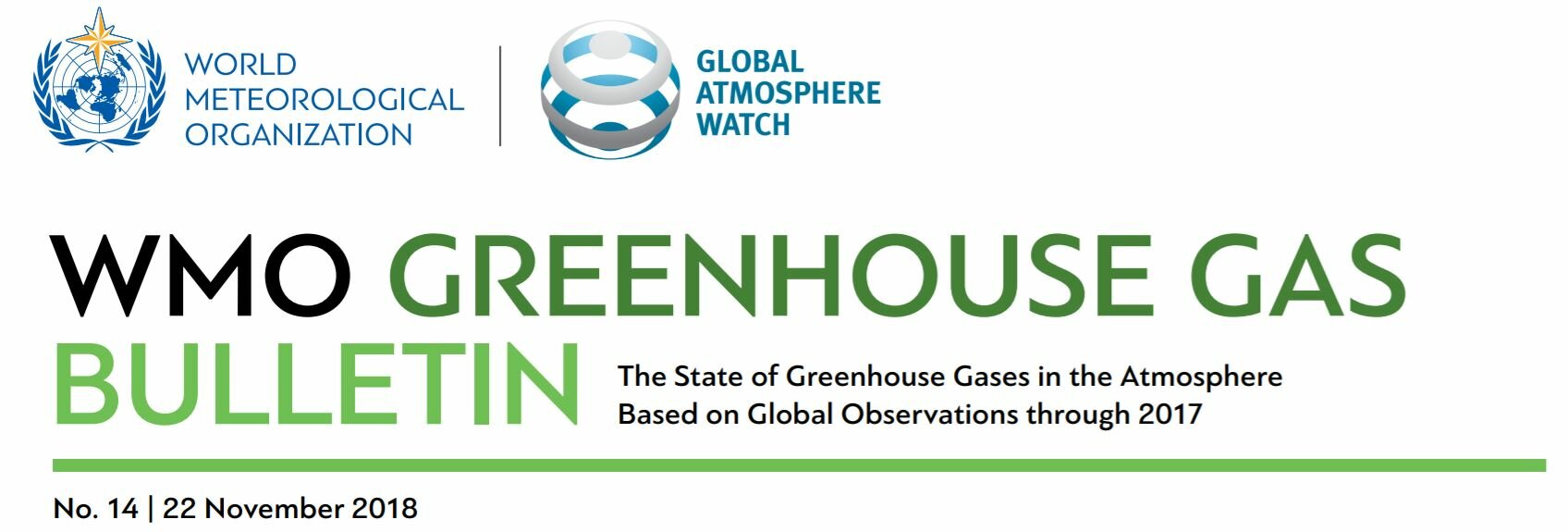

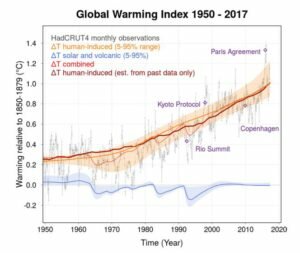
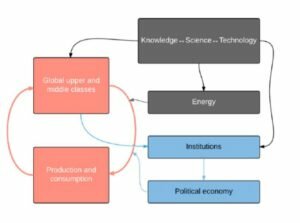
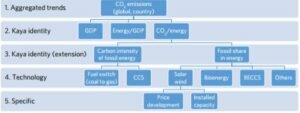

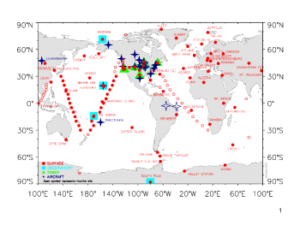 The U.S. National Oceanic & Atmospheric Administration publishes an
The U.S. National Oceanic & Atmospheric Administration publishes an